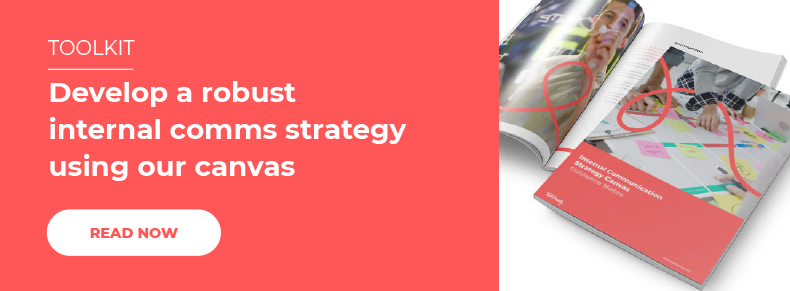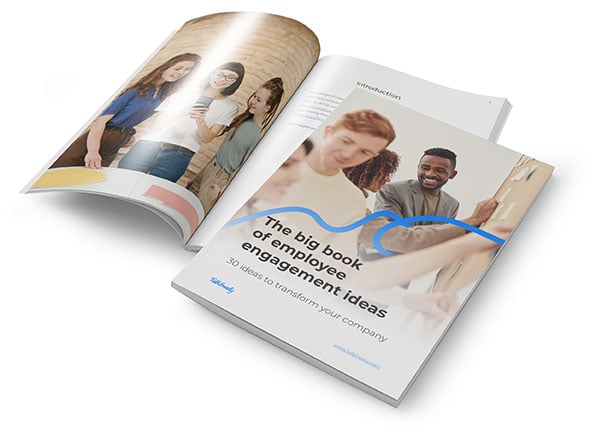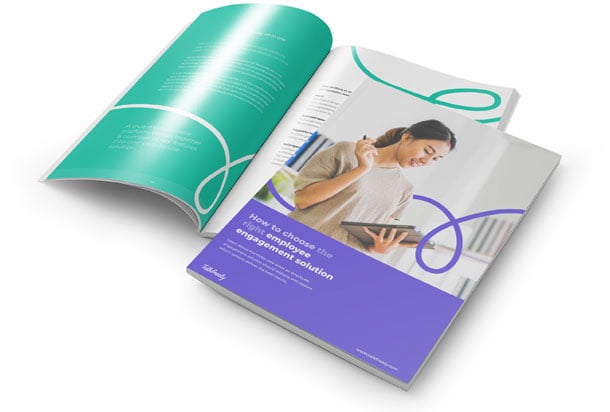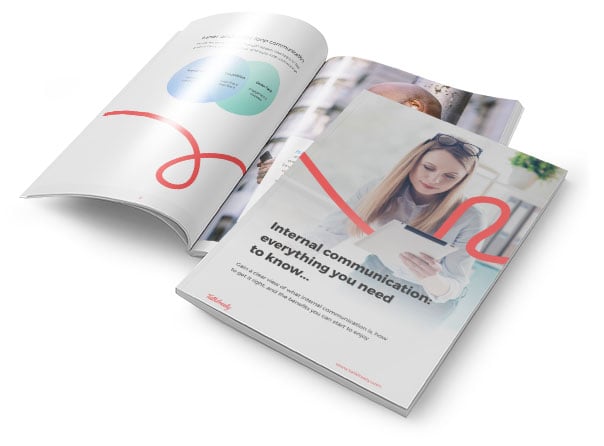Businesses around the world are currently facing exceptional levels of change. The rules are continually shifting, the challenges are growing, and uncertainty has become the only constant. In such an environment, strong internal communications are critical. You’re not only trying to reach a remote and dispersed workforce, you’re also trying to convey essential information about the required changes that will make this new situation viable.
In this guide, we take you through the essential steps for implementing a successful change communications strategy. We take a look at the definition of change communication, explore how change affects your employees, and pinpoint the 10 crucial elements of an effective change communications model.
Ultimately, whatever the situation, change is inevitable. If not handled well, change can be detrimental to business operations. However, with a solid change communications plan in place, you’ll be well prepared to take on whatever comes your way.
What is change communications?
Change communications is the transmission of information that tells employees what is changing, how this change will affect them, and what they need to do next. It helps people advance from where they currently are, to the new situation required of them.
However, it’s more than just a tool to introduce new ways of working and structural adjustments. It’s about transmitting the mindset of change. Change communications differs from the general internal communications definition in that has a strong emotive element, which is needed to overcome the natural resistance and denial of change seen in your workforce. Your aim is to provide communications that appeal positively on an emotional level.
Worth a read: This is Why Communicating Change in the Workplace Often Fails...
How do people react to change?
There is a natural, in-built resistance to change. Most people will feel a strong urge to fight against change and stick to the status quo. You’ll find that the comfort zone has a powerful draw. The reaction to Covid-19 in the workplace has been detailed by Deloitte, showing how workers’ emotional response to the pandemic follows a set pattern.
Step 1 - Denial
This will not affect my country / organisation / myself?
Step 2 - Frustration
Virus is impacting my world! Why do my professional and personal plans have to change?
Step 3 - Depression
How can I take care of my and my family’s health and wellbeing? Will there be a job or salary loss? Will there be a stoppage of essential services? Will there be a slowdown in the economy?
Step 4 - Acceptance
I understand COVID-19 realities. I’m aware of process and policy changes in my organisation. I can work from home and am empowered with tools/support.
Step 5 - Commitment
I’m ready to invest time and effort in learning. I’m keen to serve communities. I’d like to innovate my ways of working.
The aim of behaviour change communications is to move people smoothly through the steps as quickly as possible towards acceptance and commitment. Organisations need to actively coach their employees through the more difficult steps of frustration and depression. These states will have a strong negative impact on morale and productivity. Effective internal communication is crucial at this point, with a focus on providing consistent, timely messages through their preferred communication channels.
What are the main types of change?
There are many types of adjustment to be considered when implementing a change communications plan. You may be putting new technology in place, altering existing procedures, or updating the management structure.
1. Technological
Probably the most common adjustment to working life seen in recent times, an update in technology is often a sweeping change that affects all your employees. However, not all your employees will welcome this upgrade. When counteracting stubborn mindsets, the benefits of good internal communication will really pay off.
2. Strategic
You may need to instigate a major shift in strategy. For example, moving your sales off the high street to online, or launching a new product to attract a different demographic. Your focus during a strategic change should be to convince your employees of the value of the new strategy and ensure they are fully behind your plans.
3. Operational
Whether you’re reorganising departments, making leadership changes or laying people off, operational changes tend to hit employee morale hard. Concerns about job security can lead to drops in productivity and engagement. This is where you’ll need to carefully consider the emotional impact of your employee communication.
4. Objective
It could be that your business needs to implement a sweeping, largescale change in order to survive. This may mean a complete change of direction for the business and a new mission statement to go with it. When you are aiming to change the overall business objective, communicating change will be a make or break situation.
The crucial elements of change communications
When you draw up your change communications strategy, there are some key elements that should always be top of your priority list. We have identified the eight essentials that will help you to manage change effectively and successfully, whatever the situation.
1. Make sure everyone is connected
This is not a time to reach ‘most’ of your employees. You need to reach every single one, without fail. Consider putting an employee app in place. It will effortlessly connect everyone within your organisation by removing both technological and psychological barriers. By allowing employees to use their favourite internal communication channels on their own devices, you’ll automatically be ahead of the game. Whether they’re at home, in the office or on the move, you’ll have instant access to every single worker.
2. Deliver real-time communications
When it comes to communication in a crisis, timing is critical. You need to make sure that you have the technology in place to deliver instant communications when required. This is particularly important to prevent harmful gossip circulating. By ensuring everyone receives the same message at the same time, you’ll stop the rumour mill before it gets going. An internal communications app will offer instant messaging and real-time broadcasts that reach across the entire company.
3. Release regular news updates
Beware of letting your communications fall by the wayside in favour of restructuring or attending to sales figures. Often, when the pressure is on, communicating with employees is no longer a top priority. However, keep in mind that in the absence of news, employees will fill the void themselves. By scheduling regular, consistent news updates, you’ll be keeping your workforce fully informed, and alleviate the anxiety caused by silence or misinformation.
4. Provide easy access to information
When there are constant modifications to processes, procedures, structure and technology, you need to ensure everyone is fully informed and on board. Making important documentation readily available is essential. An internal communications platform will help to guarantee that this information is at employee’s fingertips. A good app will offer the option for an accessible central hub, holding all your documents, policies, training videos, Q&As and more.
5. Allow contributions and ideas
Give employees the ability to get involved in the adjustments going on around them and you’ll instantly raise engagement levels. You need them to feel part of the change, rather than subject to it. One of the key internal communication ideas for facilitating change, employee contributions can be hugely successful. An internal communications app will provide social spaces such as innovation modules that capture employee’s ideas and suggestions to address current challenges.
6. Set up feedback channels
At a time when morale is often in question, one of the key internal communication best practices is to provide free-flowing channels for feedback. You need to make it easy for employees to speak their minds and let you know they’re thinking. Whether you organise an internal communications survey to explore the impact of the change or use an employee app to schedule regular polls and quizzes, quality feedback is indispensable when setting up step change communications.
7. Maintain calendars and event schedules
When your workforce is operating remotely, it’s more important than ever to communicate essential dates and events. Properly updated calendars are a great way to improve internal communication, but sadly these often get forgotten in a crisis situation. An internal communications app will make it simple to keep on top of events. Along with multiple calendars and attendance tracking, you can also fire out new event notifications to encourage participation.
8. Create a culture of recognition
Employee goodwill is your lifeblood in challenging times. The easiest way to encourage positive feelings across the workforce is with public praise and recognition. This not only works for the employee receiving praise, but also for staff witnessing the appreciation. An employee app offers recognition modules promote peer-to-peer recognition as well as a platform for leadership praise.
Final thoughts...
There is no doubt we are facing challenging times. However, you have the opportunity to manage change faster and deliver better results. Once you have drawn up an effective strategy for change communications, your business will be set to handle shifting circumstances and uncertain futures with speed and success. As management consultant, Mark Sanborn says, “Your success isn’t based on your ability to simply change. It is based on your ability to change faster than your competition.”
Topics:
Internal Communications








